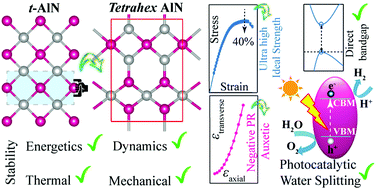Auxetic, flexible, and strain-tunable two-dimensional th-AlN for photocatalytic visible light water splitting with anisotropic high carrier mobility
-
Authors :
Mehmet Emin Kilic, Kwang-Ryeol Lee
-
Journal :
Journal of Materials Chemistry C
-
Vol :
9
-
Page :
4971-4977
-
Year :
2021

Abstract
Two-dimensional(2D) materials are considered excellent candidates for achieving a highly efficient photocatalyst. Herein, we report a novel 2D aluminum nitride monolayer (th-AlN) as a potential photocatalyst material, possessing robust energetic, dynamical, thermal, and mechanical stability as well as strong stability in aqueuos conditions. The monolayer is an indirect band gap semiconductor at its equilibrium state and can induce an indirect-to-direct band gap transition under a very small strain (−4%). The band edge positions fit perfectly the water oxidation and reduction redox potentials. The monolayer exhibits strong visible-ultraviolet light absorption, which is favorable for the efficient utilization of sunlight. The excellent electron transport ability including high and directionally anisotropic carrier mobility (104 cm2 V−1 s−1) leads to the rapid separation of electron–hole pairs, retards the recombination of electron–hole pairs, and greatly improves the photocatalytic activity. Furthermore, the monolayer exhibits exceptional mechanical properties including ultrahigh ideal strength (40%) outperforming graphene, good flexibility, and mechanical anisotropy. Remarkably, the negative Poisson's ratio makes th-AlN a promising candidate for auxetic materials. With these outstanding properties, th-AlN can be considered as a promising candidate for potential application in the fields of electronics, optoelectronics, and nanomechanics.
















